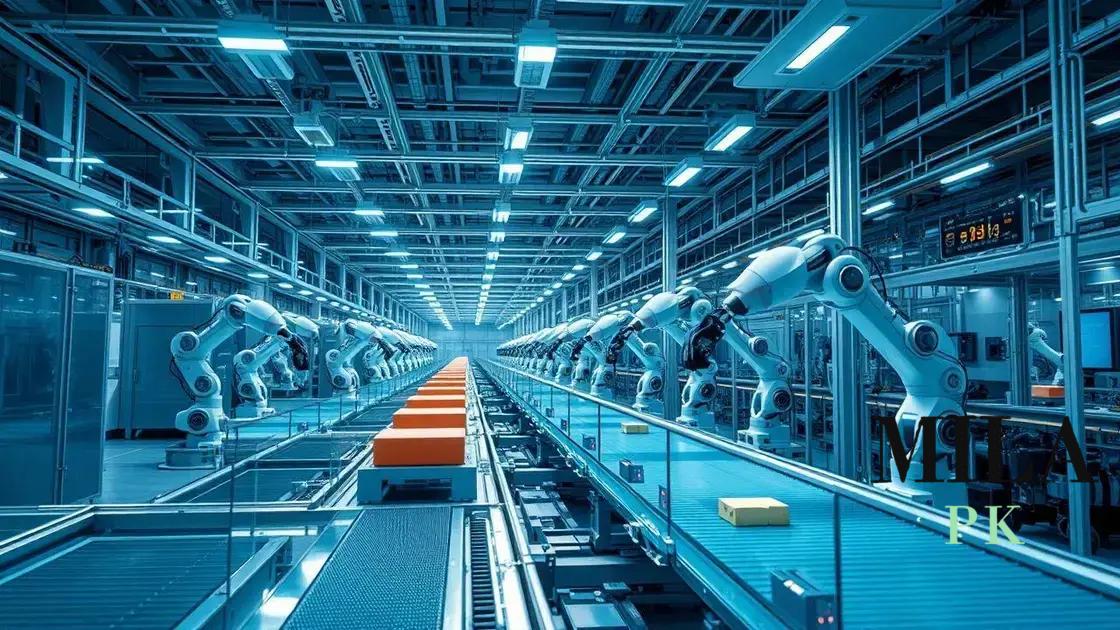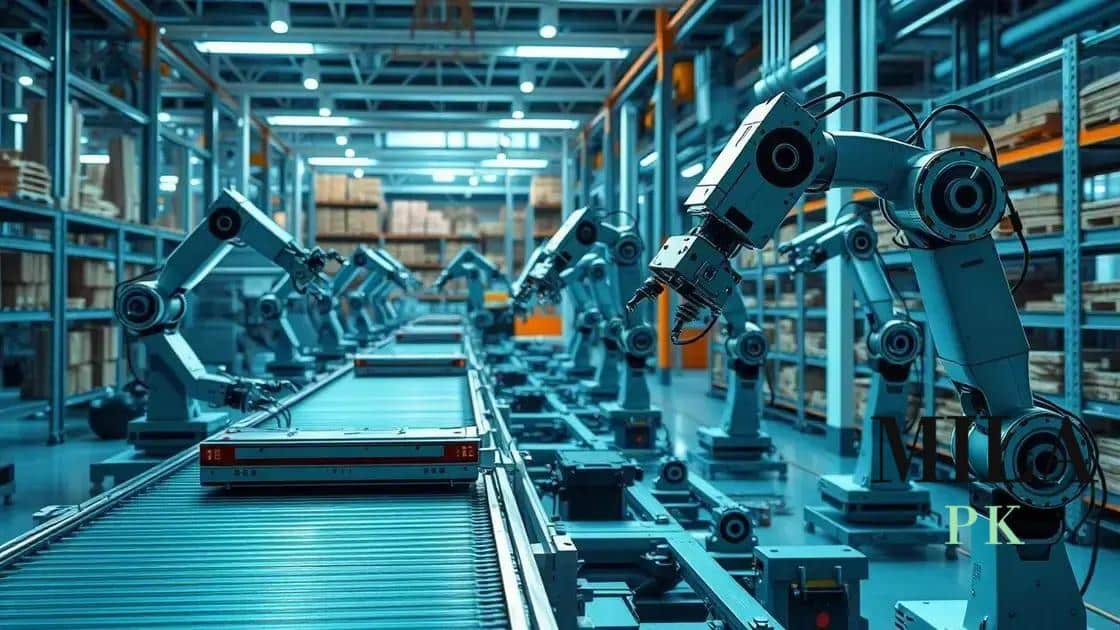Robotics innovation accelerates smart factory evolution

Robotics innovation accelerates smart factory evolution by enhancing efficiency, safety, and quality, while future trends focus on AI integration, collaborative robots, and sustainable practices in manufacturing.
Robotics innovation accelerates smart factory evolution, reshaping how industries function. Have you ever wondered how robotics can boost productivity and efficiency? This article delves into the transformative power of robotics in manufacturing.
Understanding smart factories
In today’s fast-paced world, understanding smart factories is crucial for anyone interested in modern manufacturing. These facilities utilize advanced technologies that enhance efficiency and productivity. With smart factories, traditional manufacturing processes are transformed into intelligent systems that promote better decision-making and agility.
The Core Components of Smart Factories
Smart factories rely heavily on various key elements to operate effectively. These components include:
- Internet of Things (IoT): Devices and machines are interconnected, sharing data in real-time.
- Artificial Intelligence (AI): AI algorithms analyze data to optimize processes and predict maintenance needs.
- Robotics: Automated systems handle repetitive tasks, increasing production speed and accuracy.
- Big Data: Large volumes of data from various sources are collected and analyzed to inform better business decisions.
Benefits of Smart Factory Implementation
The implementation of smart factory technologies brings numerous advantages:
- Increased Efficiency: Automation and real-time monitoring minimize downtime and streamline operations.
- Cost Savings: Reducing waste and optimizing resource allocation lead to significant savings.
- Flexibility: Smart factories can adapt quickly to changing market demands.
- Improved Quality: Enhanced monitoring ensures products meet high-quality standards consistently.
Understanding the significance of smart factories is vital for businesses aiming to remain competitive. The integration of these advanced technologies not only revamps traditional methods but also creates a more sustainable approach to manufacturing. This transformation encourages a culture of continuous improvement, where companies can thrive in an ever-evolving marketplace.
The role of robotics in automation

The role of robotics in automation is pivotal in modern manufacturing. By integrating robotic technologies, industries can optimize operations and enhance productivity. Robotics brings a variety of advantages that support not just efficiency, but also precision.
Key Functions of Robotics in Automation
Robotic systems serve various functions that streamline manufacturing processes. These functions include:
- Assembly: Robots can assemble components rapidly and with high accuracy.
- Material Handling: Robotics can transport materials within a facility, reducing the risk of human error.
- Quality Control: Automated systems consistently monitor product quality, ensuring high standards.
- Machine Maintenance: Robotic systems can perform routine maintenance checks, minimizing downtime.
The implementation of robotics results in significant improvements in overall efficiency. For example, a factory employing robotic arms can operate at higher speeds while maintaining quality. This ensures that production goals are met consistently. Additionally, businesses experience reduced labor costs, leading to greater profitability.
Challenges in Integrating Robotics
Despite the benefits, there are challenges to integrating robots into existing workflows. One challenge is the initial investment required for automation. However, this cost is often offset by the long-term savings achieved through increased productivity.
Another issue is the need for skilled personnel to operate and maintain robotic systems. Companies must invest in training and development programs to build the necessary workforce.
As industries continue to evolve, the role of robotics in automation will undoubtedly expand. Companies that embrace these technologies are well-positioned to stay ahead in competitive markets. The future of manufacturing is closely linked to advances in robotic technology, making understanding its role essential for success.
Key benefits of robotics in manufacturing
The key benefits of robotics in manufacturing are transforming how companies operate. With the integration of robotics, businesses experience significant advancements in efficiency, safety, and quality.
Enhanced Efficiency
One of the most significant advantages of robotics is enhanced efficiency. Robots can operate continuously without the need for breaks. This leads to:
- Higher Production Rates: Robotics allows for faster output without compromising quality.
- Reduced Cycle Times: Tasks that may take humans hours can be completed in minutes.
- Consistent Performance: Robots provide uniformity in production, reducing errors.
With such efficiency, manufacturers can optimize their operations, leading to more effective use of resources and time.
Improved Safety
Integrating robotics also enhances workplace safety. In environments where hazardous conditions exist, robots take over dangerous tasks. This shifts human workers to safer roles, reducing the risk of injuries. Automated systems can:
- Handle Heavy Loads: Robots can lift and transport heavy materials, minimizing strain on human workers.
- Perform Precise Tasks: Robotics can execute tasks that require extreme precision, reducing accident rates.
- Improve Work Conditions: By taking over hazardous duties, robots create a safer environment for all employees.
As a result, companies can maintain high safety standards while achieving their production goals.
Quality Control and Consistency
Robotics also plays a critical role in ensuring product quality. Automated systems can monitor and adjust processes in real time, leading to:
- Minimized Defects: Robotics consistently follow specifications, reducing product defects.
- Real-Time Data Analysis: Systems analyze results instantly, allowing for immediate corrections.
- Increased Customer Satisfaction: Higher product quality leads to better customer experiences and loyalty.
Incorporating robotics in manufacturing not only enhances the production process but also fosters an environment of continuous improvement. As industries adapt to technological advancements, the benefits of robotics will continue to revolutionize the manufacturing landscape.
Challenges of integrating robotics
Integrating robotics into manufacturing processes presents several challenges that businesses must navigate. Understanding these challenges is crucial for a successful transition to automated systems.
Initial Costs
One of the primary challenges is the high initial cost of implementing robotics. The investment involves purchasing robotic systems as well as the infrastructure needed to support them. This includes:
- System Installation: Setting up robotic systems can require extensive facilities adjustments.
- Software Integration: New systems must interface with existing software, which can incur additional costs.
- Training Expenses: Employees need training to use and maintain robotic systems effectively.
Despite these costs, businesses often find that the long-term benefits outweigh the initial investment.
Workforce Transition
Another significant challenge is managing the workforce transition. As robots take over repetitive tasks, workers may fear job loss. Companies must address this concern by:
- Offering Reskilling Programs: Training current employees for new roles in automation.
- Promoting Human-Robot Collaboration: Highlighting how robots can assist, rather than replace, human workers.
- Fostering a Culture of Adaptation: Encouraging employees to embrace new technologies.
This transition is essential for maintaining a motivated and skilled workforce in the evolving manufacturing landscape.
Technical Issues
Technical challenges also come into play with the integration of robotics. These can include:
- Maintenance Needs: Robotic systems require regular maintenance to function optimally.
- Software Bugs: Integrating new software can introduce bugs that need to be resolved.
- Downtime: Any technical issues can lead to production downtimes, affecting output.
Being prepared to tackle these challenges is vital for businesses looking to successfully integrate robotics.
Future trends in factory automation
The future trends in factory automation are set to revolutionize manufacturing practices. As technology evolves, industries embrace innovations that enhance efficiency, productivity, and sustainability.
Advancements in AI and Machine Learning
Artificial intelligence (AI) and machine learning are at the forefront of automation trends. These technologies enable systems to:
- Analyze Data: AI algorithms can process vast amounts of data to uncover patterns and improve decision-making.
- Predict Maintenance Needs: Smart systems can forecast when machines require servicing, preventing costly downtimes.
- Optimize Production: Machine learning algorithms can adjust processes in real-time for maximum efficiency.
With these advancements, factories become smarter and more responsive to changes in demand.
Increased Use of Collaborative Robots
Collaborative robots, or cobots, are gaining popularity in factory settings. Unlike traditional robots that work independently, cobots are designed to work alongside human workers. They help in various tasks, including:
- Assembly: Cobots can assist in assembling products quickly and accurately.
- Material Handling: They can transport materials, reducing physical strain on workers.
- Quality Inspection: Cobots enhance quality control by detecting defects during the production process.
This collaboration fosters a safer work environment while boosting productivity.
Sustainability Initiatives
Future trends also focus on sustainability. Factories are increasingly adopting eco-friendly practices to minimize their environmental impact. Innovations in this area include:
- Energy-Efficient Machines: New technologies consume less energy, reducing costs and emissions.
- Waste Reduction Programs: Factories aim to minimize waste through recycling and efficient resource use.
- Smart Grids: Renewable energy sources are integrated with manufacturing processes to power operations sustainably.
As sustainability becomes a priority, factories that implement these trends will lead the industry into a greener future. The combination of AI, collaborative robots, and eco-friendly practices illustrates how factory automation will evolve, paving the way for more efficient and responsible manufacturing.
FAQ – Common Questions About Robotics and Factory Automation
What are the main benefits of using robotics in manufacturing?
Robotics enhances efficiency, improves safety, and ensures consistent product quality in manufacturing processes.
How can companies overcome the challenges of integrating robotics?
Companies can provide training for employees, invest in the right technology, and gradually implement robotic systems to manage the transition.
What future trends should manufacturers look for in factory automation?
Future trends include increased AI integration, the rise of collaborative robots, and a greater focus on sustainability.
How can automation impact the workforce?
Automation can lead to job displacement in some roles, but it also creates new opportunities and requires reskilling workers for more advanced positions.





